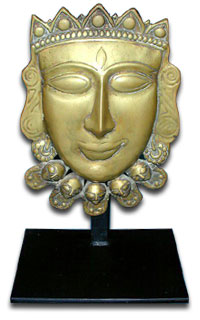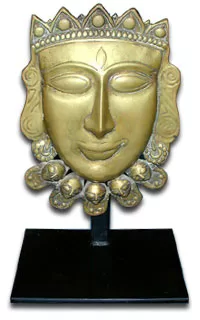It’s not uncommon for collectors — both experienced and novice — to be intimidated by Asian art.
That’s unfortunate because this fascinating field offers collectors many advantages over more conventional disciplines.
Scholarship in Asian Art increased dramatically during the past 30 years; today, interesting, easy-to-read and accurate books are readily available. Indeed, Asian art is one of the few remaining fields where a little knowledge goes a long way.
It is still possible to discover objects that others have missed, and it is not necessary to speak any of the languages to collect Asian art seriously. Although, the ability to read a few signatures is a great help, most pocket guides are enough to get started as a collector.
Homework
As in any field, before you spend any money, do a bit of homework.
Most major museums have some Asian art, and these are good places to start. Every antiques show will have Asian works of art, generally ranging from Chinese export porcelain to furniture to painted pottery tomb figures.
Most dealers and auction specialists are eager to cultivate a potential client and generally are happy to share their knowledge. Remember the old saw: opinions are like noses — everyone has one. Translation: Listen, think, and take all information with a healthy dose of common sense.
These rules apply to collecting in any field, including Asian art:
° Do your homework
° Ask questions and know what the “going” rate is for this type of art
° Buy the best example you can afford and in the best condition
° Buy what you love; chances are if you love it, someone else will love it too.
Collecting Asian Art – Try Specializing
Some collectors confine themselves to art of a particular country or region; others are interested in a specific medium (porcelain or jade); and still others concentrate on objects created during a certain time period. The choice is totally personal, and there is no better way to collect than to buy the things you love.
There is a long tradition of collecting Asian art in the West. In fact, certain disciplines, such as Japanese netsuke and Chinese tomb pottery fetch higher prices in the West than in their countries of origin.
If you love the beautiful, spiritual art of ancient India, look at collecting sacred sculptures. Dr. Stella Kramrisch, former curator of the Indian art department of the Philadelphia Art Museum, and purchase a rare treasure from her private collection of Indian art.
Some people specialise in Chinese snuff bottles, Japanese netsuke, Japanese Pottery, or Chinese Porcelain.


Asian Art Collectors Vary
It is interesting to note that most major American collectors of the 20th century, regardless of their main collecting focus, have had some Asian objects among their holdings. DuPont, Morgan, Chrysler, and Rockefeller all had Chinese porcelain, jade, and Japanese works of art among their collections.
Chinese and Japanese art influenced the Impressionist painters and many other Western artists, the designs of Louis Comfort Tiffany, and the Tiffany silversmiths.
However, it was not only the super-rich who formed important Asian collections. Typically, most collectors of Asian art come to the field after having had some type of Western collection.
As a result, the majority of them are passionate about their collections, eager to share their knowledge, and self-assured enough to collect in a field that most people do not understand. Collectors interested in Asian art can find objects at all price points, and from a wide variety of sources.
Blending Asian Ceramics Into Your Decor
Asian ceramics blend seamlessly with any style of interior.
The English “treasure houses” were filled with Chinese export ceramics, Japanese lacquer, and other Orientalia.
French palaces held vast quantities of gilt-bronze mounted Chinese ceramics, which were often mounted after they had been damaged but were too valuable (even when broken) to be discarded.
The Dutch Delft, German Meissen, and English Chelsea porcelain factories all imitated Chinese and Japanese patterns, which were prohibitively expensive at the time.
Old Master paintings often depict elaborate still life tableaux, which frequently included Chinese blue and white porcelain amidst the subject matter.


The Asian concept of looking back to a classical time and a craft tradition that values the discipline of the art rather than the individual artist’s contribution is so antithetical to our Western views that it forms a fascinating counterpoint to look at our own art and culture in a different way.
Obviously, there are exceptions to every rule, but generally Asian art tends to be undervalued in relation to the amount of artistry involved in the fabrication of each piece.
For those interested in looking at art and antiques in a new way, the question isn’t “Why Asian art?” but rather, “Why not?”
Han Dynasty male attendant tomb figure, c.206 B.C.-220 A.D
Japanese Era Names (Nengo)
| Western Calendar | Main Periods |
| 10000 BC – | Paleolithic |
| ca 10000 BC – ca 300 BC | Jomon |
| ca 300 BC – ca AD 300 | Yayoi |
| ca AD 300 – 710 | Kofun |
| AD 710 – 794 | Nara |
| 794 – 1185 | Heian |
| 1185 – 1333 | Kamakura |
| 1333 – 1568 | Muromachi |
| 1568 – 1600 | Azuchi-Momoyama |
| 1600 – 1868 | Edo |
| 1868 – 1912 | Meiji |
| 1912 – 1926 | Taisyo |
| 1926 – 1989 | Syowa |
| 1989 – | Heisei |
Chinese Dynasties & Periods
| Shang Yin | 1766 – 1122 B.C. |
| Chou | 1122 – 249 B.C. |
| Ch’in | 221 – 206 B.C. |
| Han | B.C. 206 – 220 A.D. |
| Wei | 386 – 557 A.D. |
| Sui | 581 – 618 A.D. |
| T’ang | 618 – 906 A.D. |
| Five Dynasties | 907 – 960 A.D. |
| Sung | 960 – 1279 A.D. |
| Yung | 1280 – 1368 A.D. |
| Ming | 1368 – 1614 A.D. |
| Youg Lo | 1403 – 1424 A.D. |
| Hsuan Teh | 1426 – 1435 A.D. |
| Ch’eng Hua | 1465 – 1487 A.D. |
| Chia Ching | 1522 – 1566 A.D. |
| Wan Li | 1573 – 1620 A.D. |
| Ch’ing | 1644 – 1912 A.D. |
| Shun Chih | 1644 – 1661 A.D. |
| K’ang Hsi | 1662 – 1722 A.D. |
| Yung Cheng | 1723 – 1735 A.D. |
| Ch’ien Lung | 1736 – 1795 A.D. |
| Chia Ch’ing | 1796 – 1821 A.D. |
| Tao Kuang | 1821 – 1850 A.D. |
| Hsien Feng | 1851 – 1861 A.D. |
| Tung Chih | 1862 – 1873 A.D. |
| Kuang Hsu | 1874 – 1908 A.D. |
| Hsuan T’ung | 1909 – 1912 A.D. |
| Hung Hsien | 1916 – present A.D. |
Further Reading:
The Art of Southeast Asia : Cambodia Vietnam Thailand Laos Burma Java Bali by Philip Rawson
Wisdom and Compassion: The Sacred Art of Tibet by Marylin Rhie
The Japanese Print: A Historical Guide by Hugo Munsterberg
Symbols of Japan: Thematic Motifs in Art and Design by Merrily Baird
Three Thousand Years of Chinese Painting (The Culture & Civilization of China) by Richard Barnhart
Ancient Sichuan: Treasures from a Lost Civilization by Robert Bagley
Oriental Rugs of the Silk Route:
Culture, Process, and Selection by John Gregorian
Tibetan Art: Toward a Definition of Style by Jane Casey Singer
The Japanese Print: A Historical Guide by Hugo Munsterberg
Burma’s Lost Kingdoms: Splendors of Arakan by Pamela Gutman
Japanese Ink Painting: The Art of Sumi-E by Naomi Okamoto
Masterpieces of Japanese Prints: Ukiyo-E from the Victoria and Albert Museum by Richard Lane
History of Japanese Art by Penelope Mason
Chinese Art at the End of the Millennium by John Clark
Myths and Symbols in Indian Art and Civilization by Heinrich Zimmer
The Ceramics of Southeast Asia: Their Dating and Identification by Roxanna Brown
Chinese Art and Culture by Robert Thorp
Taoism and the Arts of China by Stephen Little
A History of Far Eastern Art by Sherman Lee
The Jewelry of Nepal by Hannelore Gabriel
Tibetan Thangka Painting: Methods & Materials by David Jackson
Frank Lloyd Wright and the Art of Japan: The Architect’s Other Passion by Julia Meech-Pekarik
Art of Ancient India: Buddhist, Hindu, Jain by Susan Huntington
Indonesian Accents: Architecture, Interior Design, Art by Tan Hock Beng






